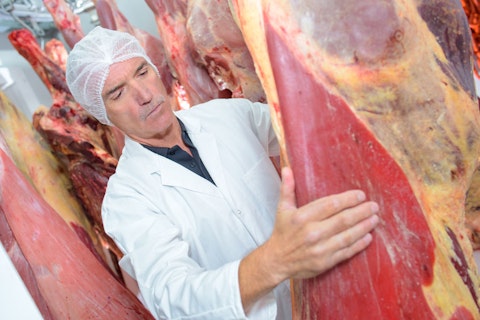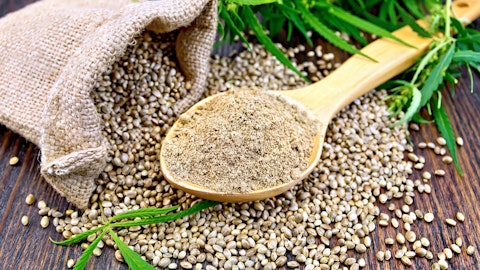In this article, we will give you a heads up on which countries will give you limited food choices if you are a vegetarian and why it is so. If you want to skip our overview of the growing interest in vegetarianism and veganism, read 8 Worst Countries in the World For Vegetarians.
While vegetarianism is gaining traction, there are still some of the worst countries in the world for vegetarians where food choices are restrictive. For instance, China is one of the most difficult countries for vegetarians because even if a certain Chinese dish doesn’t contain meat, it might have animal-based products like lard. Similarly, Argentina is renowned for its meat-based cuisine and is notoriously difficult for vegetarians.
As the world’s second-largest beef consumer, Argentine culinary traditions often revolve around asado, a type of barbeque, making it difficult to find varied vegetarian options. Mongolia’s extreme climate also necessitates a diet heavy on animal-based food, such as mutton and beef, so vegans and vegetarians face a hard time finding appropriate food in the country.
Which Country Is Mostly Vegetarian?
India has the largest percentage of vegetarians amongst its population, as 24% of people in the country have veg diets. Major religions practiced in India, such as Hinduism, Jainism, and Buddhism, promote vegetarianism as a spiritual practice. Also, vegetarianism has deep roots in Indian society and is associated with notions of purity, non-violence, and holistic health.
We have already discussed 20 Countries With the Highest Rates Of Vegetarians; go through our list to know where veg food preferences are the most prevalent.
Growing Popularity of Vegetarian and Vegan Diets
The vegetarian industry is gaining mainstream acceptance as more consumers shift towards plant-based diets due to health, environmental, and ethical concerns. The global vegetarian food market is valued at $52.5 billion in 2023 and is expected to reach $95.5 billion by 2029.
Likewise, the global vegan food market, which comprises meat substitutes, dairy alternatives, and vegetarian meals, was valued at $23.3 billion in 2020. According to a report from Fortune Business Insights, the vegan market is forecasted to reach $61.35 billion by 2028, growing at a CAGR of 12.95% between 2021-2028. Such high forecasted growth indicates a strong demand for plant-based products and purely vegan food alternatives.
Consumer behavior impacts this expanding industry. A study by Ipsos MORI in 2018 revealed that approximately 5% of the world’s population identified as vegetarian, while 3% of people were pure vegan. The percentages are expected to rise, given the trend towards plant-based diets. The report found that the younger population is more likely to follow a meat-free diet, while older people are mostly omnivorous. Also, interestingly, women prefer vegetarian and vegan food options more than men. Statista’s Consumer Insights of 2023 also found that 86% of respondents surveyed in 21 countries had meat-containing diets.
The veg industry’s expansion is also fueled by companies developing innovative products to make plant-based diets more accessible and appealing. For example, Beyond Meat, Inc. (NASDAQ:BYND) has made significant strides in the creation of meat substitutes that mimic the taste, texture, and nutritional profile of animal products. These products by Beyond Meat, Inc. (NASDAQ:BYND) offer good taste without the environmental and ethical issues associated with livestock farming. Beyond Meat, Inc. (NASDAQ:BYND) ‘s plant-based meat substitutes help new vegetarians and vegans satiate their cravings while keeping their diet meat-free.
Moreover, traditional food companies and restaurants are adopting more inclusive strategies to cater to vegetarians. Fast-food giants like McDonald’s Corporation (NYSE:MCD), KFC, and Burger King now offer plant-based options. For instance, McDonald’s Corporation (NYSE:MCD) ‘s Double McPlant Burger uses 2 Beyond Meat patties, a vegan sandwich sauce, and a vegan cheese alternative. Likewise, McDonald’s Corporation (NYSE:MCD) ‘s Vegetable Deluxe burger uses vegetables along with a vegan sandwich sauce.
Tyson Foods Inc (NYSE:TSN) is also investing heavily in its vegetarian product lines to become more inclusive for varying food preferences. Tyson Foods Inc (NYSE:TSN) also announced plans to launch plant-based products in select markets in Asia-Pacific, which includes products like plant-based nuggets, bites, and filets. This expansion underlines Tyson Foods Inc (NYSE:TSN) ‘s recognition of the increasing global appetite for plant-based alternatives.
However, the vegetarian food industry’s rapid growth also prompts questions about the global food industry’s adaptability and sustainability. Challenges like insufficient protein content in plant-based food, maintaining taste, and overcoming cultural and perceptual barriers to adoption limit the industry’s expansion. Despite these, the industry’s projected growth signifies a shift in global food systems as people are becoming more conscious about what they consume and the companies they are associated with.
Which Country is 100% Non Vegetarian?
As per our findings, there’s no country where 100% of the population is non-vegetarian. However, some countries have a higher consumption of meat because of cultural or religious factors, i.e., China, Brazil, and the USA, among others.
Some Asian nations have high meat consumption rates, but others, like India, have significant vegetarian populations due to cultural and religious factors. Also, many Muslim-majority nations consume a lot of meat, especially during certain religious holidays, but there are also vegetarian and vegan individuals in these countries.
Similarly, the United States, Australia, and Argentina are the top meat consumers per capita. However, this does not mean these countries are 100% non-vegetarian, as dietary habits are diverse and complex.
As people’s environmental and ethical concerns are changing their food choices, some countries still follow their carnivorous diets; learn about the Top 20 Countries with the Highest Meat Consumption.
Let’s now move toward the worst countries for vegetarians.

15 Worst Countries in the World for Vegetarians
Our Methodology
We selected the worst countries in the world for vegetarians based on their prevalent cuisine preferences and meat consumption. For instance, if a country has substantial meat consumption, it hints that vegetarian food is not common in the country. When a nation’s religious and cultural inclination is towards carnivorous cuisine, vegetarians have a hard time finding meat-free food there. Similarly, countries like South Korea and Japan have extensive shorelines, so naturally, their food revolves around seafood.
So based on our understanding of different regions’ eating habits, here are the worst countries for vegetarians:
15. Mongolia
Mongolia’s traditional cuisine is heavily based on meat and dairy, as the country’s historical lifestyle was nomadic, which required nutrient-dense food sources. The country’s harsh winters make vegetable cultivation challenging, and there’s a heavy reliance on animal products for sustenance. The Mongolian diet features mutton, beef, and horse meat, evidenced by the per capita meat consumption of 102 kgs per year. Vegetarian options are not typically part of the traditional fare, which can make Mongolia one of the worst countries in the world for vegetarians.
14. Iceland
Like Mongolia, the climate in Iceland results in a diet high in seafood and lamb. As the country has volcanic terrain and harsh winters, growing produce isn’t typical in Iceland. Icelandic specialties like wind-dried fish and smoked lamb are staples, whereas vegetarian alternatives are often imported and can be expensive. Furthermore, cultural dining occasions such as “Þorrablót” are about consuming various types of preserved meat. Such carnivorous inclination may limit options for vegetarians, as finding a meat-free diet will take some research.
13. Latvia
Latvia’s cuisine is influenced by its Baltic climate and agricultural abundance. The diet includes pork, potatoes, and rye bread, with a lesser emphasis on fresh fruits and vegetables. Dishes like breaded pork cutlets and sausages are commonplace, while vegetarianism is less prevalent. Although Latvia’s urban areas are seeing an increase in vegetarian and vegan options, more common eateries in rural areas may not offer a wide range of plant-based dishes.
12. Uruguay
Uruguay is renowned for its asado barbecue, and beef is an essential part of virtually every traditional dish in the country. Uruguayans have one of the highest per-capita meat consumption rates in the world, standing at 53 kgs. Although urban areas like Montevideo are beginning to offer more vegetarian options, much of its cuisine makes it one of the worst countries in the world for vegetarians.
11. Portugal
Portugal heavily favors seafood and meat in its cuisine. Iconic dishes like salted cod, bean stew with pork, and suckling pig dominate local menus. Vegetarian alternatives can be scarce, especially in rural areas. Despite a slowly growing vegetarian culture in larger cities like Lisbon, many traditional eateries in Portugal may not offer substantial plant-based options. Almost 1.2% of the country’s population is vegetarian, so naturally, pure veg food options are limited for visitors or natives who want to eat a meat-free diet.
10. Philippines
The Philippines has a cuisine deeply rooted in meat and seafood. The concept of vegetarianism is not widely recognized in the country, and many dishes may contain hidden animal products like fish sauce, shrimp paste, or chicken stock. Moreover, the per capita annual meat consumption in the Philippines is 33.74 kgs, one of the highest in the world.
9. South Africa
In South Africa, the traditional cuisine is largely meat-centric, and the country’s per capita meat consumption is 59.77 kgs. The popular ‘Braai’ culture, similar to Western-style barbecues, is deeply embedded in the South African lifestyle and is the cuisine’s focal point. Additionally, the country’s culinary landscape reflects a strong presence of meat in the national palate and may limit vegetarian options.
Click to continue reading 8 Worst Countries in the World For Vegetarians.
Suggested Articles:
- Vegetable Consumption per Capita by Country
- 10 Best Organic Food and Farming Stocks To Buy
- 20 Most Profitable Food Businesses in the World
Disclosure: None. 15 Worst Countries in the World For Vegetarians is originally published at Insider Monkey.


